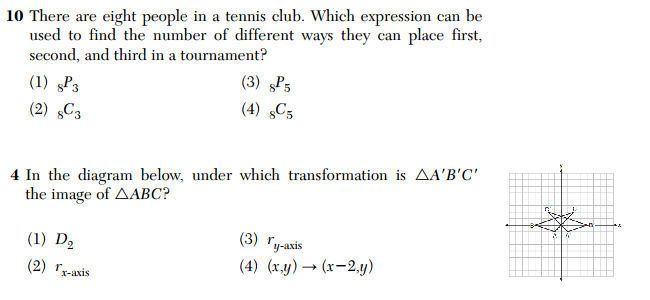Here is another installment in my series reviewing the NY State Regents exams in mathematics.
There seems to be some confusion among the Regents exam writers about when students are supposed to learn about lines and parabolas. Consider number 39 from the January 2013 Integrated Algebra exam:
Compare the above problem with number 39 from the June 2012 Geometry exam:
 These questions are essentially equivalent. They both require solving a system of equations involving a linear function and a quadratic function by graphing. Yet, they appear in the terminal exams of two different courses, that are supposed to assess two different years of learning.
These questions are essentially equivalent. They both require solving a system of equations involving a linear function and a quadratic function by graphing. Yet, they appear in the terminal exams of two different courses, that are supposed to assess two different years of learning.
When, exactly, is the student expected to learn how to do this? If the answer is “In the Geometry course”, the Algebra teacher can hardly be held accountable if the student doesn’t know how to solve this problem. And if the answer is “In the Integrated Algebra course”, what does it mean if the student gets the problem wrong on the Geometry exam? Is that the fault of the Geometry teacher or the Algebra teacher? The duplication of this topic raises questions about the validity of using these tests to evaluate teachers.
And if that isn’t confusing enough, check out this problem from the 2011 Algebra 2 / Trig exam.
 Here, we see the same essential question, except now the student is required to solve this system algebraically. These three exams–Integrated Algebra, Geometry, Algebra 2/Trig–span at least three years of high school mathematics. In the integrated Algebra course, a student is expected to solve this problem by graphing. Then, 2 to 3 years later, a student is expected to be able to solve the same kind of problem algebraically.
Here, we see the same essential question, except now the student is required to solve this system algebraically. These three exams–Integrated Algebra, Geometry, Algebra 2/Trig–span at least three years of high school mathematics. In the integrated Algebra course, a student is expected to solve this problem by graphing. Then, 2 to 3 years later, a student is expected to be able to solve the same kind of problem algebraically.
What does that say about these tests as measures of student growth?





